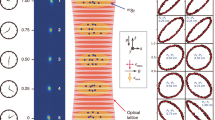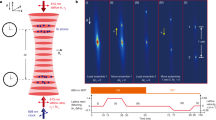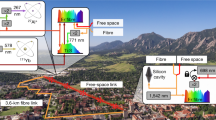Abstract
Einstein’s theory of general relativity states that clocks at different gravitational potentials tick at different rates relative to lab coordinates—an effect known as the gravitational redshift1. As fundamental probes of space and time, atomic clocks have long served to test this prediction at distance scales from 30 centimetres to thousands of kilometres2,3,4. Ultimately, clocks will enable the study of the union of general relativity and quantum mechanics once they become sensitive to the finite wavefunction of quantum objects oscillating in curved space-time. Towards this regime, we measure a linear frequency gradient consistent with the gravitational redshift within a single millimetre-scale sample of ultracold strontium. Our result is enabled by improving the fractional frequency measurement uncertainty by more than a factor of 10, now reaching 7.6 × 10−21. This heralds a new regime of clock operation necessitating intra-sample corrections for gravitational perturbations.
This is a preview of subscription content, access via your institution
Access options
Access Nature and 54 other Nature Portfolio journals
Get Nature+, our best-value online-access subscription
$29.99 / 30 days
cancel any time
Subscribe to this journal
Receive 51 print issues and online access
$199.00 per year
only $3.90 per issue
Buy this article
- Purchase on Springer Link
- Instant access to full article PDF
Prices may be subject to local taxes which are calculated during checkout




Similar content being viewed by others
Data availability
The experimental data are available from the corresponding authors upon reasonable request.
Code availability
The code used for the analysis is available from the corresponding authors upon reasonable request.
References
Einstein, A. Grundgedanken der allgemeinen Relativitätstheorie und Anwendung dieser Theorie in der Astronomie. Preuss. Akad. der Wissenschaften, Sitzungsberichte 315, 778–786 (1915).
Chou, C. W., Hume, D. B., Rosenband, T. & Wineland, D. J. Optical clocks and relativity. Science 329, 1630–1633 (2010).
Herrmann, S. et al. Test of the gravitational redshift with Galileo satellites in an eccentric orbit. Phys. Rev. Lett. 121, 231102 (2018).
Delva, P. et al. Gravitational redshift test using eccentric Galileo satellites. Phys. Rev. Lett. 121, 231101 (2018).
Campbell, S. L. et al. A Fermi-degenerate three-dimensional optical lattice clock. Science 358, 90–94 (2017).
Oelker, E. et al. Demonstration of 4.8 × 10−17 stability at 1 s for two independent optical clocks. Nat. Photon. 13, 714–719 (2019).
Nicholson, T. et al. Systematic evaluation of an atomic clock at 2 × 10−18 total uncertainty. Nat. Commun. 6, 6896 (2015).
McGrew, W. F. et al. Atomic clock performance enabling geodesy below the centimetre level. Nature 564, 87–90 (2018).
Brewer, S. M. et al. 27Al+ quantum-logic clock with a systematic uncertainty below 10−18. Phys. Rev. Lett. 123, 33201 (2019).
Bothwell, T. et al. JILA SrI optical lattice clock with uncertainty of 2.0 × 10−18. Metrologia 56, 065004 (2019).
Marti, G. E. et al. Imaging optical frequencies with 100 μHz precision and 1.1 μm resolution. Phys. Rev. Lett. 120, 103201 (2018).
Pedrozo-Peñafiel, E. et al. Entanglement on an optical atomic-clock transition. Nature 588, 414–418 (2020).
Kaubruegger, R. et al. Variational spin-squeezing algorithms on programmable quantum sensors. Phys. Rev. Lett. 123, 260505 (2019).
Kómár, P. et al. Quantum network of atom clocks: a possible implementation with neutral atoms. Phys. Rev. Lett. 117, 060506 (2016).
Young, A. W. et al. Half-minute-scale atomic coherence and high relative stability in a tweezer clock. Nature 588, 408–413 (2020).
Safronova, M. S. et al. Search for new physics with atoms and molecules. Rev. Mod. Phys. 90, 25008 (2018).
Sanner, C. et al. Optical clock comparison for Lorentz symmetry testing. Nature 567, 204–208 (2019).
Kennedy, C. J. et al. Precision metrology meets cosmology: improved constraints on ultralight dark matter from atom-cavity frequency comparisons. Phys. Rev. Lett. 125, 201302 (2020).
Boulder Atomic Clock Optical Network. Frequency ratio measurements at 18-digit accuracy using an optical clock network. Nature 591, 564–569 (2021).
Kolkowitz, S. et al. Gravitational wave detection with optical lattice atomic clocks. Phys. Rev. D 94, 124043 (2016).
Hafele, J. C. & Keating, R. E. Around-the-world atomic clocks. Science 177, 166 (1972).
Takamoto, M. et al. Test of general relativity by a pair of transportable optical lattice clocks. Nat. Photon. 14, 411–415 (2020).
Laurent, P., Massonnet, D., Cacciapuoti, L. & Salomon, C. The ACES/PHARAO space mission. C. R. Phys. 16, 540–552 (2015).
Tino, G. M. et al. SAGE: a proposal for a space atomic gravity explorer. Eur. Phys. J. D 73, 228 (2019).
Grotti, J. et al. Geodesy and metrology with a transportable optical clock. Nat. Phys. 14, 437–441 (2018).
Flechtner, F., Sneeuw, N. & Schuh, W.-D. (eds) Observation of the System Earth from Space: CHAMP, GRACE, GOCE and Future Missions (Springer, 2014).
Kolkowitz, S. et al. Spin–orbit-coupled fermions in an optical lattice clock. Nature 542, 66–70 (2017).
Bromley, S. L. et al. Dynamics of interacting fermions under spin–orbit coupling in an optical lattice clock. Nat. Phys. 14, 399–404 (2018).
Wilkinson, S. R., Bharucha, C. F., Madison, K. W., Niu, Q. & Raizen, M. G. Observation of atomic Wannier–Stark ladders in an accelerating optical potential. Phys. Rev. Lett. 76, 4512–4515 (1996).
Lemonde, P. & Wolf, P. Optical lattice clock with atoms confined in a shallow trap. Phys. Rev. A 72, 1–8 (2005).
Aeppli, A. et al. Hamiltonian engineering of spin-orbit coupled fermions in a Wannier-Stark optical lattice clock. Preprint at https://arxiv.org/abs/2201.05909 (2022).
Muniz, J. A., Young, D. J., Cline, J. R. K. & Thompson, J. K. Cavity-QED measurements of the 87Sr millihertz optical clock transition and determination of its natural linewidth. Phys. Rev. Res. 3, 023152 (2021).
Ludlow, A. D., Boyd, M. M., Ye, J., Peik, E. & Schmidt, P. O. Optical atomic clocks. Rev. Mod. Phys. 87, 637–701 (2015).
Zheng, X. et al. Differential clock comparisons with a multiplexed optical lattice clock. Nature https://doi.org/10.1038/s41586-021-04344-y (2022).
Matei, D. G. et al. 1.5 µm lasers with sub-10 mHz linewidth. Phys. Rev. Lett. 118, 263202 (2017).
Lemonde, P., Brusch, A., Targat, R. L., Baillard, X. & Fouche, M. Hyperpolarizability effects in a Sr optical lattice clock. Phys. Rev. Lett. 96, 103003 (2006).
Lodewyck, J., Zawada, M., Lorini, L., Gurov, M. & Lemonde, P. Observation and cancellation of a perturbing dc Stark shift in strontium optical lattice clocks. IEEE Trans. Ultrason. Ferroelectr. Freq. Control 59, 411–415 (2012).
Leibfried, D., Blatt, R., Monroe, C. & Wineland, D. Quantum dynamics of single trapped ions. Rev. Mod. Phys. 75, 281–324 (2003).
Boyd, M. M. et al. Nuclear spin effects in optical lattice clocks. Phys. Rev. A 76, 022510 (2007).
Martin, M. J. et al. A quantum many-body spin system in an optical lattice clock. Science 341, 632–636 (2013).
Ushijima, I. et al. Operational magic intensity for Sr optical lattice clocks. Phys. Rev. Lett. 121, 263202 (2018).
van Westrum, D. Geodetic Survey of NIST and JILA Clock Laboratories, Boulder, Colorado (NOAA, 2019).
Acknowledgements
We acknowledge funding support from the Defense Advanced Research Projects Agency, National Science Foundation QLCI OMA-2016244, the DOE Quantum System Accelerator, the National Institute of Standards and Technology, National Science Foundation Phys-1734006 and the Air Force Office for Scientific Research. We are grateful for theory insight from A. Chu, P. He and A. M. Rey. We acknowledge J. Zaris, J. Uhrich, J. Meyer, R. Hutson, C. Sanner, W. Milner, L. Sonderhouse, L. Yan, M. Miklos, Y. M. Tso and S. Kolkowitz for stimulating discussions and technical contributions. We thank J. Thompson, C. Regal, J. Hall and S. Haroche for careful reading of the manuscript.
Author information
Authors and Affiliations
Contributions
All authors contributed to carrying out the experiments, interpreting the results and writing the manuscript.
Corresponding authors
Ethics declarations
Competing interests
The authors declare no competing interests.
Peer review
Peer review information
Nature thanks the anonymous reviewers for their contribution to the peer review of this work. Peer reviewer reports are available.
Additional information
Publisher’s note Springer Nature remains neutral with regard to jurisdictional claims in published maps and institutional affiliations.
Extended data figures and tables
Supplementary information
Rights and permissions
About this article
Cite this article
Bothwell, T., Kennedy, C.J., Aeppli, A. et al. Resolving the gravitational redshift across a millimetre-scale atomic sample. Nature 602, 420–424 (2022). https://doi.org/10.1038/s41586-021-04349-7
Received:
Accepted:
Published:
Issue Date:
DOI: https://doi.org/10.1038/s41586-021-04349-7
This article is cited by
-
Wavelength-accurate nonlinear conversion through wavenumber selectivity in photonic crystal resonators
Nature Photonics (2024)
-
Correlated sensing with a solid-state quantum multisensor system for atomic-scale structural analysis
Nature Photonics (2024)
-
Multi-ensemble metrology by programming local rotations with atom movements
Nature Physics (2024)
-
Direct comparison of two spin-squeezed optical clock ensembles at the 10−17 level
Nature Physics (2024)
-
Affordable medium-finesse optical cavity for diode laser stabilization
Applied Physics B (2024)
Comments
By submitting a comment you agree to abide by our Terms and Community Guidelines. If you find something abusive or that does not comply with our terms or guidelines please flag it as inappropriate.



